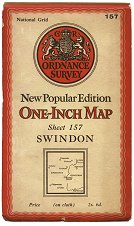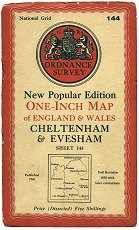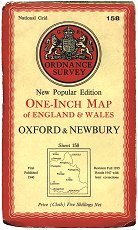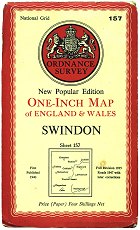1938-1943: A difficult birth
Work began on the 1-inch New Popular Edition in the late 1930s, after the Davidson Committee (see 1-inch Fifth Edition) recommended a metric grid should be used on the Ordnance Survey’s maps.
The plan for the New Popular Edition was to use the latest available mapping from either the 1-inch Popular Edition or the 1-inch Fifth Edition, re-jigged into 190 sheets of 40km × 45km each, to cover Great Britain. The intention was then to update each sheet based on 1-inch Popular Edition material with information from the ‘Fourth National Revision’ at the 1-inch scale (on which the 1-inch Fifth Edition was based) as it became available. The series would be based on the Transverse Mercator projection - as the Fifth Edition had been.
In May 1939, with drawing work progressing well on the new series, it was the intention of the Ordnance Survey to begin publication of the New Popular Edition the following Spring. The advent of the Second World War, however, put such plans on hold.
The Fourth National Revision at the 1-inch scale was abandoned in May 1940, officially because of ‘unspecified difficulties encountered by the revisers’ - likely because of the disruption and redistribution of priorities caused by the War. By June, efforts were concentrated on updating the military’s maps of Great Britain.
The Germans carried out two nights of bombing over Southampton, on 30 November and 1 December 1940, targeting the Ordnance Survey’s headquarters. This led to the destruction of all the New Popular Edition drawings still being worked on. Luckily the few completed New Popular sheets had been copied to enamels in preparation for printing, and these survived. Also surviving were the enamels from the completed sheets of the 1-inch Fifth Edition.
In 1940-41, eleven New Popular Edition sheets were printed, but publication was blocked by the War Office, who felt that the Home Guard and other military personnel could be easily confused by the new grid system - their military issues (see 1-inch War Revisions) used a completely different grid.
By 1943 it was clear that not much more effort could be spent on the New Popular Edition, and the sheets intended for Scotland were officially abandoned.
1944-1948: Restart and publication
Work on the New Popular Edition was picked up again in 1944. Those areas for which no 1-inch Fifth Edition mapping was available were covered by simply copying the latest 1-inch Popular Edition mapping, revised for important changes and altered to fit the new projection.
 Figure 1 1-inch New Popular Edition cover (c.1940, pub. 1945) |
 Figure 2 1-inch New Popular Edition cover (c.1946) |
After the end of the Second World War, a rapid publication programme for the 1-inch New Popular Edition began.
The first 20 sheets were published in September 1945. Some copies of the eleven sheets printed in 1940-41 had already been put inside covers at some point prior to 1944. These covers were designed by Ellis Martin, although gone were the elaborate full-face engravings of his previous designs. ‘Ordnance Survey’, ‘New Popular Edition’ and ‘One-Inch Map’ were all in hand-lettering. Examples are relatively scarce. (Figure 1). For details of the sheets involved, see the themed category page.
All other sheets - and other copies of those printed in 1940-41 - were issued in an entirely letterpress-style cover. (Figure 2)
It soon became clear that the New Popular Edition was not going to be a long-term commitment. The quality of the finished maps left a lot to be desired, and in 1947 it was decided to begin work on a completely new series: the 1-inch Seventh Series.
By December 1947, all 115 New Popular Edition sheets covering England & Wales had been published.
1949-1959: The road to replacement
 Figure 3 1-inch New Popular Edition cover (c.1950) |
 Figure 4 1-inch New Popular Edition cover (c.1954) |
A slight refinement in design of the lettering on the covers was introduced around 1949/50. (Figure 3)
After Queen Elizabeth II came to the throne in 1952, references to ‘G.R.’ were removed from the covers. (Figure 4)
Gradually the 1-inch Seventh Series replaced the New Popular Edition from September 1952 onwards. The New Popular sheets were kept in print, with minor revisions, until their replacements were published.
Page last updated: 14 April 2012